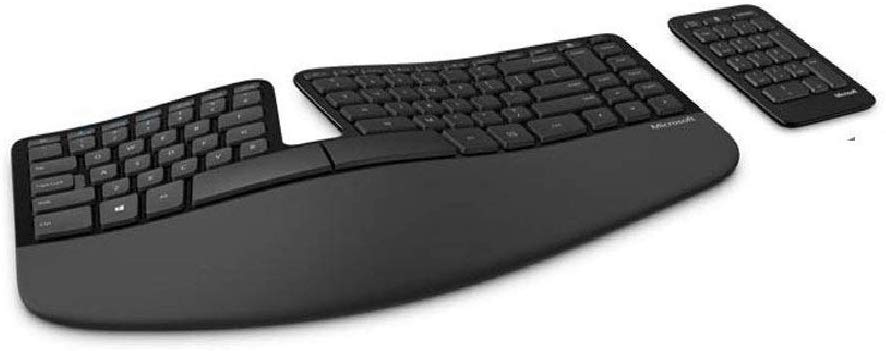Given the current situation, chances are that you’re working from home or might soon be asked to work from home.
If you’ve never done this before, it might seem daunting. Here are some tips we recommend for doing so effectively.
Get the Right Equipment
Working directly from your company-issued laptop might be fine for a few days. But for an extended stay, it’s a much better experience to have multiple monitors, a real keyboard, and a mouse.
We recommend the following:
Monitor: Dell 24” UltraSharp U2415

This is a 24-inch monitor with more vertical space than a typical widescreen monitor, which is more suited for reviewing business documents and email.
Inexpensive Keyboard & Mouse Combo: Logitech MK270 Keyboard and Mouse ($23)

If you don’t want to spend a lot of money on a dedicated keyboard and mouse, this is a great upgrade from your laptop peripherals at an affordable price.
Upgrade Ergonomic Keyboard: Microsoft Sculpt Ergonomic Keyboard ($75)

For a bit more money, this keyboard is much more comfortable to use. It has a split design that rises in the middle, which is easier on your wrists.
Upgrade Mouse: Logitech MX Master 3 ($100)

This mouse has extra buttons (forward, back, app switch), a better scroll wheel, and a secondary side-to-side scroll, which is great for large Excel documents.
Headset: Jabra Evolve 40 UC ($109)

You’ll want a quality headset for the increased number of GoToMeeting/Zoom/Microsoft Teams calls you’ll be on. This one is comfortable and features a microphone to make calls seamless.
Dock: Dell WD19 USB C Dock ($156)

A dock provides the ports you might need to hook up monitors to your laptop. It makes the process of connecting and disconnecting everything more accessible.
Surge Protector: APC SurgeArrest 8-Outlet Surge Protector ($24)

A quality surge protector will protect all of your equipment from damage.
Security
When working from home, you’ll also need to make sure you’re staying safe. Here are some considerations to keep in mind.
Connection Security
You might require a remote access technology to connect to the resources you need in the office. Here are some standard methods to do this:
- Firewall-based VPN
Your company’s firewall, like a Fortinet FortiGate firewall, can facilitate a network connection to your work. Files, databases, and other resources can be transferred from the office to your home through a secure “tunnel.” In this method, you continue to operate normally on your computer as if you were in the office, and files that you need are transferred over the internet to you.- Pros: You can operate just like you’re in the office with your laptop.
- Cons: If you work on large files, the speed of your internet connection will determine how quickly they open. Often, this means it will be much slower to open large files remotely.
- Third-Party VPN
A third-party VPN technology, like Perimeter 81, can simplify the process of connecting to a VPN. It operates very similarly to a firewall-based VPN. - Remote Desktop
Your company might have a Remote Desktop server, previously known as a Terminal Server. When you establish a connection, you are working directly on the server in the office, with only screenshots that are sent back to your local computer.- Pros: You can open large files quickly. This type of remote access is often used even when people are in the office, so the experience is identical no matter where they are.
- Cons: Because it sends screenshots back to your computer, video and pictures can sometimes be slow to load and more choppy, especially on poor internet connections. This type of remote access usually requires an expensive infrastructure investment that most companies do not make.
Computer Security
When you are working from home, you will no longer be protected by your company’s firewall, which can help filter out malicious websites and other threats. With that layer removed, your computer will be more likely to get an infection.
To help with this, we recommend maintaining at least these two layers of defense:
- Antivirus software: Your computer probably has this, and it should work both in the office and at home.
- Cisco Umbrella DNS Filtering: This secondary filtering technology can help fill in the gap as the second layer of protection. It works both in the office and out. If your business is not currently using this technology, we can help. Take a look at our overview of Cisco Umbrella for some basics.
Watch out for Coronavirus-themed phishing attempts. They’ll try and trick you with some sensational headlines or other forms attention-grabbing, then either infect your computer or try and steal your username and password.
Keeping your computer adequately maintained and monitored for issues can help prevent problems and notify technical resources when there is one. The software that we use functions both in the office and from home. We are well-equipped to continue to provide you with assistance no matter where you are located.
Avoid letting the kids or others use your business computer. Doing so increases the computer’s risk of infection, which could then spread across a VPN. Keep the business computer for work and use a different device for personal activities.
Staying Sane When Working from Home
I worked from home for eight years. Here are some tips that I found helpful:
Create a Focused Workspace
Find a quiet place in your home with a desk and the ability to close the door. If there are others, inform them of the times you will be focusing on work and the times you plan to take breaks, so they have the right expectations.
Enforce these times, so there is less work distraction. If you’re in a noisy environment, consider using headphones, and put on non-distracting music, like brain.fm.
Dress Normally
When working from home, it’s tempting to hang out in your pajamas all day. However, the way we dress can have an impact on our state of mind.
If we are dressed for work, we are priming our minds to focus on work. If you dress like you would when relaxing, we will subconsciously prime our brain to get into that state instead.
Follow Your Typical Routine as Much as Possible
If you wake up a particular time, continue that schedule. Go to bed at your usual time too. It’s wise to avoid making changes to your routine that might be difficult to reverse later.
Take Breaks

Every so often, get up and walk around. Go outside and breathe some fresh air if you can. It’s easier to avoid the feeling of being cooped up by taking an outdoor walk or hike.
The Pomodoro Technique is one time management method that has you schedule regular breaks in between periods of work. Using an external timer, like this one from Time Timer, can help with this. Experiment a bit and find what works best for you.
Call People on the Phone
Stay in contact with people like you usually would. This will help reduce the feeling of social isolation.
Take Advantage of the Quiet
Assuming your home environment is quiet, you’ll probably have more time for focused activities than in an office setting. Use this to your advantage to plan, think, and execute tasks that require a higher amount of concentrated attention.
How Do You Like Working From Home?
With a little planning and preparation, you can be nearly as effective at home as you are in the office.
If you have any tips, feel free to post them in the comments!




